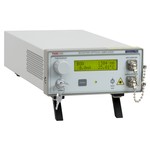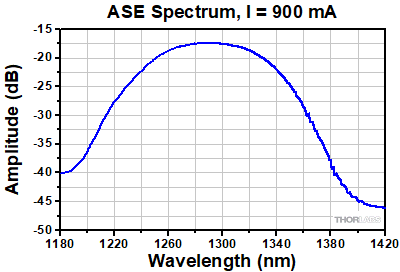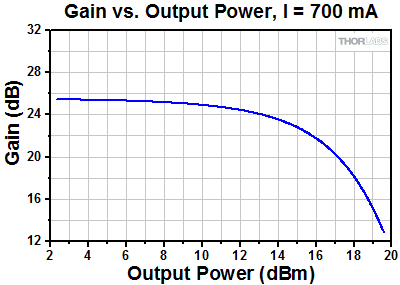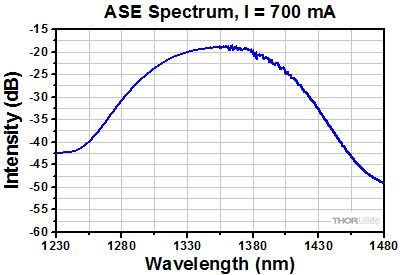
O-Band Booster Optical Amplifiers (BOAs), 1285 - 1350 nm

- Polarization-Dependent Booster Optical Amplifiers
- SM or PM Fiber-Pigtailed Butterfly Package
- High Saturation Power (>15 dBm)
BOA1130S
High-Power BOA with SM Fiber and FC/APC Connectors
BOA1132P
BOA with PM Fiber and FC/APC Connectors, Closeup of Butterfly Package Shown
FC/APC Connectors
OVERVIEW
| Optical Amplifier Selection Guide |
|---|
| 780 - 795 nm BOAs |
| 830 nm BOAs |
| 930 nm BOAs |
| 980 nm BOAs |
| 1050 nm BOAs |
| 1210 nm BOAs |
| 1250 nm BOAs |
| O-Band (1285 - 1350 nm) BOAs |
| E-Band (1410 nm) BOAs |
| C-Band (1550 nm) BOAs and SOAs |
| L-Band (1590 - 1625 nm) BOAs |
| 1685 nm BOAs |

Click to Enlarge
When current is applied across the ridge waveguide, excited state electrons are stimulated by input light, leading to photon replication and signal gain.
Features
- Polarization Dependent: Amplifies Only One Polarization State
- Center Wavelengths Available Between 1285 nm and 1350 nm
- Available with Either SM or PM Fiber Pigtails (1.5 m)
- 2.0 mm Narrow Key FC/APC Connectors
- 2.5 dB Coupling Loss at Each Chip End
- High Saturation Power (>15 dBm), High Efficiency
- 3 dB Bandwidth: 70 nm, 80 nm, 82 nm, or 87 nm (Typical)
- AR-Coated End Faces on Chip (R < 0.1%)
- Typical Applications: Boosting Laser Transmitters, Compensating for Transmit
MUX/DeMUX Insertion Loss, and Optical Shutters
Booster Optical Amplifiers (BOAs) are single-pass, traveling-wave amplifiers that perform well with both monochromatic and multi-wavelength signals. Since BOAs only amplify one state of polarization, they are best suited for applications where the input polarization of the light is known. For applications where the input polarization is unknown or fluctuates, a Semiconductor Optical Amplifier (SOA) is required. However, the gain, noise, bandwidth, and saturation power specifications of a BOA are superior to that of an SOA because of the design features that make the SOA polarization insensitive.
The BOA consists of a highly-efficient InP/InGaAsP Multiple Quantum Well (MQW) layer structure. As seen in the schematic to the right, the input and output of the amplifier is coupled to the reliable ridge waveguide on the optical amplifier chip. Losses typically range from 1.5 to 2.5 dB at both the fiber-to-chip and chip-to-fiber couplings. These coupling losses affect the total gain, noise figure (NF), and saturation power (Psat). While the gain produced by the amplifier exceeds that of the losses, these losses remain an important factor in determining the device's performance. For instance, a 1 dB drop in input coupling efficiency increases the noise figure by 1 dB. Alternatively, a 1 dB drop in output coupling decreases the saturation power by 1 dB.
The device is contained in a standard 14-pin butterfly package with either SM or PM fiber pigtails that are terminated with FC/APC connectors. The connector key is aligned to the slow axis on all PM fiber pigtailed models. Optional polarization-maintaining isolators at the input, output, or both input/output are also available (specifications may vary with different configurations). Please contact Tech Support to order such a device.
Thorlabs also offers other components suitable for the O-Band, including our high-speed transmitter and receivers and Praseodymium-Doped Fiber Amplifier (PDFA). The PDFA should be used for applications requiring O-band signal transmission amplficiation with low-noise and minimal signal latency.

Click to Enlarge
Our BOA1132P optical amplifier is also available in the S9FC1132P benchtop optical amplifier.
Driver Option
The CLD1015 butterfly LD/TEC controller is one possible controller for these amplifiers. This LD/TEC controller and mount combination offers full control via a touch screen. When operating the BOAs on this page with the CLD1015, the orientation for type 1 pin configurations should be used.
Center Wavelength Note
The center wavelength (CWL) of the amplified spontaneous emission (ASE) spectrum in broadband semiconductor devices such as optical amplifiers may show variation between lots. Please refer to the Specs tab for the CWL tolerances of each particular model. For applications in which a specific ASE center wavelength is a critical concern, please contact Tech Support for information on the CWL of currently available lots.
| Item #a,b | Center Wavelength | 3 dB Bandwidth | Saturated Output Power (@ -3 dB) |
Small Signal Gain (@ Pin = -20 dBm) |
Noise Figure |
|---|---|---|---|---|---|
| BOA1130S and BOA1130P | 1285 nm | 87 nm | 19 dBm | 30 dB | 7 dB |
| BOA1310S and BOA1310P | 1290 nmc | 82 nm | 20.5 dBmd,e | 32 dB | 7.0 dB |
| BOA1132S and BOA1132P | 1300 nm | 87 nm | 17 dBm | 30 dB | 7 dB |
| BOA1017S and BOA1017P | 1310 nm | 70 nm | 17 dBm | 28 dB | 7.0 dB |
| BOA1036S and BOA1036P | 1350 nm | 80 nm | 15 dBm | 23 dB | 8 dB |
SPECS
| Item # | Symbol | BOA1130S and BOA1130P | ||
|---|---|---|---|---|
| Min | Typical | Max | ||
| Operating Current | IOP | - | 700 mA | 750 mA |
| Center Wavelength | λC | 1265 nm | 1285 nm | 1295 nm |
| Optical 3 dB Bandwidth | BW | 80 nm | 87 nm | - |
| Saturation Output Powera (@ -3 dB) | PSAT | 18 dBm | 19 dBm | - |
| Optical Input Power | PIN | - | - | 70 mW |
| Small Signal Gain (@ Pin = -20 dBm, λ = 1312 nm) |
G | 27 dB | 30 dB | - |
| Gain Ripple (RMS) @ IOP | ΔG | - | 0.2 dB | 0.3 dB |
| Noise Figure | NF | - | 7 dB | 9 dB |
| Forward Voltage | VF | - | 1.6 V | 2.0 V |
| TEC Operation (Typ./Max @ TCASE = 25 °C / 70 °C) | ||||
| TEC Current | ITEC | - | 0.4 A | 1.5 A |
| TEC Voltage | VTEC | - | 0.5 V | 4.0 V |
| Thermistor Resistance | RTH | - | 10 kΩ | - |
| Item # | Symbol | BOA1310S and BOA1310P | ||
|---|---|---|---|---|
| Min | Typical | Max | ||
| Operating Current | IOP | - | 900 | 1000 mA |
| Center Wavelengtha | λC | 1275 nm | 1290 nm | 1305 nm |
| Optical 3 dB Bandwidth | BW | 75 nm | 82 nm | - |
| Saturation Output Powerb (@ -3 dB, IOP, λ = 1312 nm) |
PSAT | 20 dBm | 20.5 dBm | - |
| Optical Input Power | PIN | - | - | 70 mW |
| Small Signal Gain (@ Pin = -20 dBm, IOP, λ = 1312 nm) |
G | 28.5 dB | 32 dB | - |
| Gain Ripple (RMS, @ IOP) | ΔG | - | 0.12 dB | 0.35 dB |
| Noise Figure (@ IOP, λ = 1312 nm) | NF | - | 7.0 dB | 9.5 dB |
| Forward Voltage (@ IOP) | VF | - | 1.5 V | 2.0 V |
| TEC Operation (Typ./Max @ TCASE = 25 °C / 70 °C) | ||||
| TEC Current | ITEC | - | 0.5 A | 1.5 A |
| TEC Voltage | VTEC | - | 0.7 V | 4.0 V |
| Thermistor Resistance | RTH | - | 10 kΩ | - |
| Item # | Symbol | BOA1132S and BOA1132P | ||
|---|---|---|---|---|
| Min | Typical | Max | ||
| Operating Current | IOP | - | 700 mA | 750 mA |
| Center Wavelength | λC | 1290 nm | 1300 nm | 1315 nm |
| Optical 3 dB Bandwidth | BW | 80 nm | 87 nm | - |
| Saturation Output Powera (@ -3 dB) | PSAT | 15 dBm | 17 dBm | - |
| Optical Input Power | PIN | - | - | 70 mW |
| Small Signal Gain (@ Pin = -20 dBm, λ = 1312 nm) |
G | 27 dB | 30 dB | - |
| Gain Ripple (RMS) @ IOP | ΔG | - | 0.2 dB | 0.3 dB |
| Noise Figure | NF | - | 7 dB | 9 dB |
| Forward Voltage | VF | - | 1.6 V | 2.0 V |
| TEC Operation (Typ./Max @ TCASE = 25 °C / 70 °C) | ||||
| TEC Current | ITEC | - | 0.4 A | 1.5 A |
| TEC Voltage | VTEC | - | 0.5 V | 4.0 V |
| Thermistor Resistance | RTH | - | 10 kΩ | - |
| Item # | Symbol | BOA1017S and BOA1017P | ||
|---|---|---|---|---|
| Min | Typical | Max | ||
| Operating Current | IOP | - | 600 mA | 750 mA |
| Center Wavelength | λC | 1290 nm | 1310 nm | 1330 nm |
| Optical 3 dB Bandwidth | BW | 60 nm | 70 nm | - |
| Saturation Output Powera (@ -3 dB) | PSAT | 15 dBm | 17 dBm | - |
| Optical Input Power | PIN | - | - | 70 mW |
| Small Signal Gain (@ Pin = -20 dBm, IOP, λ = 1312 nm) |
G | 24 dB | 28 dB | - |
| Gain Ripple (RMS) @ IOP | ΔG | - | 0.1 dB | 0.25 dB |
| Polarization Extinction Ratio | PER | - | 16 dB | - |
| Noise Figure | NF | - | 7.0 dB | 9.0 dB |
| Forward Voltage | VF | - | 1.4 V | 1.6 V |
| TEC Operation (Typ./Max @ TCASE = 25 °C / 70 °C) | ||||
| TEC Current | ITEC | - | 0.15 A | 1.5 A |
| TEC Voltage | VTEC | - | 0.35 V | 4.0 V |
| Thermistor Resistance | RTH | - | 10 kΩ | - |
| Item # | Symbol | BOA1036S and BOA1036P | ||
|---|---|---|---|---|
| Min | Typical | Max | ||
| Operating Current | IOP | - | 700 mA | 750 mA |
| Center Wavelength | λC | 1330 nm | 1350 nm | 1370 nm |
| Optical 3 dB Bandwidth | BW | 65 nm | 80 nm | - |
| Saturation Output Powera (@ -3 dB, λ = 1312 nm) |
PSAT | 13 dBm | 15 dBm | - |
| Optical Input Power | PIN | - | - | 70 mW |
| Small Signal Gain (@ Pin = -20 dBm, IOP, λ = 1312 nm) |
G | 20 dB | 23 dB | - |
| Gain Ripple (RMS) @ IOP | ΔG | - | - | 0.3 dB |
| Noise Figure | NF | - | 8 dB | 11 dB |
| Forward Voltage | VF | - | 1.6 V | 2.0 V |
| TEC Operation (Typ./Max @ TCASE = 25 °C / 70 °C) | ||||
| TEC Current | ITEC | - | 0.4 A | 1.5 A |
| TEC Voltage | VTEC | - | 0.5 V | 4.0 V |
| Thermistor Resistance | RTH | - | 10 kΩ | - |
PIN DIAGRAM

Mechanical Drawing and Pin Assignments
GRAPHS
Note: All plots illustrate typical performance, and individual units may have slightly different performance, within the parameters outlined on the Specs tab.
BOA1130S and BOA1130P Graphs
The gain vs. output power plot shown below for the BOA1130S and BOA1130P was measured with an operating current of 700 mA and an input wavelength of 1312 nm. The amplified spontaneous emission (ASE) spectrum was also measured at an operating current of 700 mA.
BOA1310S and BOA1310P Graphs
The gain vs. output power plot swas measured for the BOA1310P optical amplifier with an operating current of 900 mA and an input wavelength of 1312 nm. The amplified spontaneous emission (ASE) spectrum was also measured at an operating current of 900 mA. The BOA1310S shows similar performance (see the Spec Sheet by clicking on the red docs icon below for more information).
BOA1132S and BOA1132P Graphs
The gain vs. output power plot shown below for the BOA1132S and BOA1132P was measured with an operating current of 700 mA and an input wavelength of 1312 nm. The amplified spontaneous emission (ASE) spectrum was also measured at an operating current of 700 mA.
BOA1017P and BOA1017S Graphs
The gain vs. output power plot shown below for the BOA1017P and BOA1017S was measured with an operating current of 600 mA and an input wavelength of 1312 nm. The amplified spontaneous emission (ASE) spectrum was also measured at an operating current of 600 mA.
BOA1036P and BOA1036S Graphs
The gain vs. output power plot shown below for the BOA1036P and BOA1036S was measured with an operating current of 700 mA and an input wavelength of 1312 nm. The amplified spontaneous emission (ASE) spectrum was also measured at an operating current of 700 mA. Please note: the ripple on the ASE spectrum curve below is due to water absorption during the test and not indicative of the performance of the device.
OPTICAL AMPLIFIERS

Booster optical amplifiers (BOAs) and semiconductor optical amplifiers (SOAs) are single-pass, traveling-wave amplifiers that perform well with both monochromatic and multi-wavelength signals. Since BOAs only amplify one state of polarization, they are best suited for applications where the input polarization of the light is known. For applications where the input polarization is unknown or fluctuates, a Semiconductor Optical Amplifier (SOA) is required. However, the gain, noise, bandwidth, and saturation power specifications of a BOA are superior to that of a SOA because of the design features that make the SOA polarization insensitive.
BOAs and SOAs are similar in design to Fabry-Perot Laser Diodes, the difference being that Fabry-Perot laser diodes have reflective coatings on both end faces of the semiconductor chip. The optical feedback from the reflective end faces establishes a cavity in which lasing can occur. SOAs and BOAs have an anti-reflection (AR) coating on both end faces of the semiconductor chip. The AR coatings limit the optical feedback into the chip so that lasing does not occur.
As is typical for all amplifiers, BOAs/SOAs operate in two regimes: a linear, flat, constant gain regime and a non-linear, saturated output regime. When used to amplify a modulated signal, the linear regime is typically used to eliminate pattern-dependent distortion, multi-channel cross-talk, and transient response issues common to EDFAs. The non-linear regime is used to take advantage of the highly non-linear attributes of the semiconductor gain medium (cross-gain modulation, cross phase modulation) to perform wavelength conversion, optical 3R regeneration, header recognition, and other high-speed optical signal processing functions.
For a continuous wave input signal, the amount of power that can be produced by the amplifier is determined by the saturation output power (Psat) parameter. Psat is defined as the output power at which the small-signal gain has been compressed by 3 dB. The maximum amount of CW power that can be extracted is approximately 3 dB higher than the saturation power.

O-Band BOAs with SM Fiber Pigtails
Part Number | Description | Price | Availability |
|---|---|---|---|
BOA1130S | O-Band Booster Optical Amplifier, CWL = 1285 nm (Typ.), Butterfly Pkg, SMF, FC/APC | $2,660.95 | Today |
BOA1310S | O-Band Booster Optical Amplifier, CWL = 1290 nm (Typ.), Butterfly Pkg, SMF, FC/APC | $3,018.88 | Today |
BOA1132S | O-Band Booster Optical Amplifier, CWL = 1300 nm (Typ.), Butterfly Pkg, SMF, FC/APC | $2,539.78 | Today |
BOA1017S | O-Band Booster Optical Amplifier, CWL = 1310 nm (Typ.), Butterfly Pkg, SMF, FC/APC | $2,356.83 | Today |
BOA1036S | O-Band Booster Optical Amplifier, CWL = 1350 nm (Typ.), Butterfly Pkg, SMF, FC/APC | $2,356.83 | Today |
O-Band BOAs with PM Fiber Pigtails
Part Number | Description | Price | Availability |
|---|---|---|---|
BOA1130P | O-Band Booster Optical Amplifier, CWL = 1285 nm (Typ.), Butterfly Pkg, PMF, FC/APC | $2,988.81 | Today |
BOA1310P | O-Band Booster Optical Amplifier, CWL = 1290 nm (Typ.), Butterfly Pkg, PMF, FC/APC | $3,238.44 | Today |
BOA1132P | O-Band Booster Optical Amplifier, CWL = 1300 nm (Typ.), Butterfly Pkg, PMF, FC/APC | $2,867.65 | Today |
BOA1017P | O-Band Booster Optical Amplifier, CWL = 1310 nm (Typ.), Butterfly Pkg, PMF, FC/APC | $2,696.58 | Today |
BOA1036P | O-Band Booster Optical Amplifier, CWL = 1350 nm (Typ.), Butterfly Pkg, PMF, FC/APC | $2,696.58 | Today |










